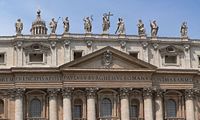Borghese family
| Borghese | |
|---|---|
Italian noble family | |
 Arms of the Borghese family | |
| Country | |
| Current region | |
| Founded | 1238 |
| Founder | Tiezzo da Monticiano |
| Current head | H.E. Don Scipione II, Prince Borghese, 14th Prince of Sulmona, 15th Prince of Rossano (b. 1970) |
| Titles | Numerous titles
|
| Motto | In Utroque Vigil |
The House of Borghese is a princely family of
Borghese (Borghesi) of Siena
The family originated with Tiezzo da Monticiano, a 13th-century wool merchant in Siena, whose nephew Borghese gave his name to the family. Among the important Sienese Borghese are:
- Agostino (1390–1462), noted soldier in the wars between Siena and Florence, named count palatine by Pope Pius II and count of the Holy Roman Empire by Sigismund
- Niccolò (1432–1500), man of letters, philosopher, and important political figure in the Sienese republic, belonging to the Monte dei Nove.
- Pietro (1469–1527), named a senator of Rome by Pope Leo X, killed in the Sack of Rome.
- Marcantonio (1504–1574), politician and lawyer in papal service.
Borghese of Rome
The head of the family, Marcantonio, Patrician of Siena, moved to Rome in 1541 and this Sienese family rapidly gained access to the upper echelons of Roman society, culminating in the election of Marcantonio's son Camillo Borghese as Pope Paul V in 1605. Paul V was an unabashed nepotist, naming his brother Francesco (1556–1620) Duke of Rignano and general of the papal army, his other brother Giambattista (1554–1609) Governor of the Borgo and castellan of Castel Sant'Angelo, and his sister Ortensia's son Scipione Caffarelli (1577–1633), becoming Scipione Borghese on his adoption) a Cardinal and his adoptive son. Paul also bestowed on his nephew Scipione the title Prince of Vivero on (November 17, 1609). As an extended family, the Borghese became some of the largest landowners of the Roman Campagna, increasing their wealth by their strategic control of their properties and a concerted policy of assuming monopolies of milling grain and the rights to run inns.

Thus the Borghese family rose still further in power and wealth. Many of Paul V's official inscriptions include ROMANUS after his name, to reinforce the family's new Roman connection. Scipione was a major patron of the arts, and the
Marcantonio II (1598–1658), son of Giambattista, was named prince of Sulmona in 1610 (Grandee of Spain of 1st class), again through Paul V's influence, in this case with
His grandson
Marcantonio IV's second son, prince Francesco Borghese-Aldobrandini (1776–1839), was also a general in the Napoleonic army, and inherited all Camillo's property. Francesco had married Adèle de La Rochefoucauld, daughter of Alexandre-Francois, and their son Marcantonio married Thérèse de La Rochefoucauld, daughter of Alexandre-Jules (brother of Adèle).
His great-grandson Prince
His nephew
There are 4 present branches of the Borghese family:
- Borghese, descended from Marcantonio V, princes of Sulmona, Rossano, son of Francesco
- Borghese-Aldobrandini, descended from Camillo, princes of Meldola, son of Francesco
- Borghese-Salviati, descended from Scipione, dukes of Giuliano, son of Francesco
- Borghese-Torlonia, Giulio (1847–1914), princes of Fucino, grandson of Francesco, married princess Anna Maria Torlonia
Notable members of the family
- Scipione Borghese (1577–1633): cardinal, artistic patron of Bernini, and nephew of Pope Paul V
- Pope Paul V (1605–1621): né Camillo Borghese (1550–1621)
- Paolo Borghese (1622–1646), he married Olimpia Aldobrandini
- Francesco Scipione Maria Borghese (1697–1759): cardinal
- Marcantonio Borghese (1730–1800): rebuilt the Villa Borghese and its gardens
- Camillo Filippo Ludovico Borghese(1775–1832): second husband of Pauline Bonaparte
- Napoleonand wife of Camillo Borghese
- Scipione Borghese (1871–1927): politician and explorer
- Giangiacomo Borghese (1889–1954): 6th fascist governor of Rome (1939–1944) and husband of the 13th Princess of Leonforte
- Paolo Borghese(1904–1985): Duke of Bomarzo and husband of Marcella Borghese
- Junio Valerio Borghese (1906–1974): Italian naval commander and politician
- Marcella Borghese, née Fazi (1911–2002): cosmetics entrepreneur and wife of Paolo Borghese
- Lorenzo Borghese (b. 1972): entrepreneur and television personality
References
Sources
- Chisholm, Hugh, ed. (1911). . Encyclopædia Britannica (11th ed.). Cambridge University Press.
- Castello Di Borghese Castello Di Borghese, Vineyard and Winery, Cutchogue, New York
- Original 1922 Almanach de Gotha (edited by Justice Perthes) entry for the Borghese family, link to the original universally-recognised genealogical reference document, with details of family honours
